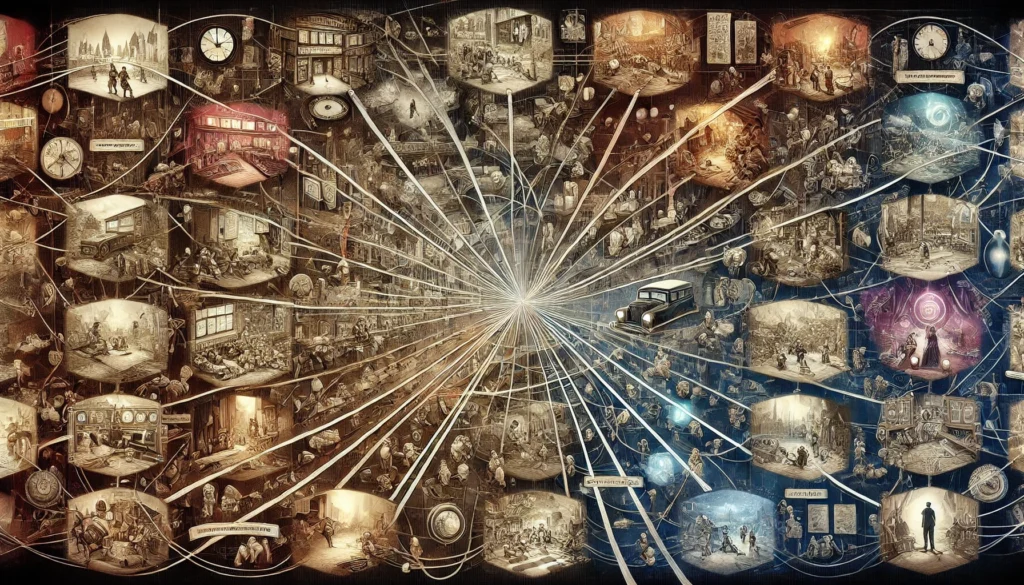
Discover the Best Book Recommendations Today
Finding great books can seem hard, but with the right help, you can find your next favorite. A good website for book recommendations can guide
The Official Website of E.B. Brown

Nonlinear narratives, which disrupt the traditional, chronological flow of a story, have become a powerful storytelling tool in both literature and film. By manipulating time and structure, nonlinear narratives offer new ways of engaging with a story, inviting audiences to piece together the narrative in a more active and often more complex manner. These narratives challenge the linear progression of events, allowing for a deeper exploration of themes like memory, perception, identity, and fate. Whether in literature or film, nonlinear storytelling pushes the boundaries of traditional narrative forms and opens up innovative ways of crafting meaning.
In literature, nonlinear narratives have been used for centuries, with authors experimenting with time and structure to create more layered and multifaceted stories. James Joyce's Ulysses (1922) is often cited as one of the earliest and most influential works to embrace a nonlinear narrative structure. The novel unfolds in a single day, but its fragmented, stream-of-consciousness style moves back and forth in time, showing the interior lives of its characters in a disjointed way. By breaking the chronology, Joyce allows readers to experience the psychological complexity of his characters and the fluidity of time and memory. Similarly, in Virginia Woolf’s Mrs. Dalloway (1925), the narrative jumps between past and present, capturing the fragmented thoughts of characters as they move through the day, highlighting the instability of memory and how the past continually influences the present.
One of the strengths of nonlinear narratives in literature is that they mirror the way human consciousness works—our thoughts, memories, and emotions are not confined to a linear progression. Writers can use techniques such as flashbacks, shifts in perspective, and non-chronological sequencing to show how events in the past shape the present, revealing complex emotional and psychological layers. In works like The Sound and the Fury by William Faulkner, nonlinear time structures allow the narrative to delve into the fragmented minds of its characters, exploring themes of memory, loss, and the passage of time. Faulkner’s use of different viewpoints, especially in the section narrated by Benjy, a character with intellectual disabilities, challenges readers to understand time from a disjointed, fragmented perspective.
In film, nonlinear narratives similarly disrupt the conventional structure of storytelling, but the visual and auditory components of the medium offer unique ways to present time shifts. Films such as Pulp Fiction (1994) by Quentin Tarantino and Memento (2000) by Christopher Nolan are exemplary of how nonlinear narratives can create suspense, surprise, and deeper thematic exploration. In Pulp Fiction, Tarantino jumbles the chronology of the story, mixing multiple plotlines and characters. The film’s fragmented structure allows the audience to see events out of order, and by piecing the narrative together, viewers gain a more intricate understanding of how the characters’ actions and decisions are interconnected. The disjointed nature of the film highlights the randomness of life, fate, and consequence, while also allowing for a rich exploration of character development and moral ambiguity.
Memento, directed by Christopher Nolan, takes nonlinear storytelling to another level by having the film unfold backward in time. The protagonist, Leonard Shelby, suffers from short-term memory loss and is attempting to solve his wife’s murder, but he can only remember moments for a short time. The film’s reversed structure forces the audience to experience Leonard’s confusion and disorientation, mimicking his cognitive state and creating a deep empathy for his plight. By disorienting the viewer with a fragmented narrative, Memento underscores themes of memory, identity, and the reliability of perception, showing how our understanding of events is shaped by our subjective experience.
Nonlinear narratives also allow filmmakers and writers to explore themes of fate and destiny. In films like Eternal Sunshine of the Spotless Mind (2004), directed by Michel Gondry, the nonlinear structure is used to mirror the cyclical nature of relationships and memory. The film’s narrative shifts back and forth in time as the protagonists, Joel and Clementine, undergo a procedure to erase each other from their memories. The disjointed storytelling represents how memories are often revisited and revised, reflecting the tension between erasing the past and learning from it. The nonlinear structure also emphasizes the idea that relationships are not linear but rather exist in a continuous loop of highs and lows, reinforcing the film's themes of love, loss, and reconciliation.
In literature, nonlinear narratives can also explore themes of trauma, identity, and the complexity of human experience. Works like Beloved by Toni Morrison use fragmented time structures to reflect the psychological scars of slavery and trauma. The novel weaves together past and present narratives to depict the haunting effects of memory and the difficulty of escaping the past. Similarly, in The Night Circus by Erin Morgenstern, the narrative shifts between different timelines and perspectives, building a sense of mystery and allowing the reader to see the magical world of the circus from various angles. The nonlinear structure enhances the novel’s dreamlike, fantastical atmosphere, and reflects the themes of competition, fate, and choice.
Nonlinear narratives also emphasize the importance of perspective. In films like The Tree of Life (2011), directed by Terrence Malick, the nonlinear structure allows the narrative to flow between different moments in time, from the creation of the universe to the childhood of the protagonist, Jack. The fragmented narrative highlights the interconnectedness of human experience, showing how the smallest moments in a person’s life are linked to the larger, cosmic forces of nature and existence. This structure challenges the audience to view time as fluid and interconnected, reflecting on the complexity of life and the human experience.
In conclusion, nonlinear narratives in both literature and film offer a profound way of engaging with time, memory, and perception. These stories are often more complex and layered, requiring audiences to actively participate in piecing together the narrative and interpreting the connections between past, present, and future. Whether exploring psychological complexity, trauma, or the randomness of life, nonlinear storytelling allows for a deeper and more nuanced exploration of the human experience. By breaking away from traditional linear narratives, these stories create an immersive experience that reflects the fragmented, nonlinear nature of memory and identity.

Finding great books can seem hard, but with the right help, you can find your next favorite. A good website for book recommendations can guide

Connecting with fellow book lovers can open up new worlds and build lasting friendships. A local Reading Community offers a sense of belonging and enriches

The rise of digital publishing has made E-book Platform solutions more popular. With many online e-book platforms out there, picking the right one is key.